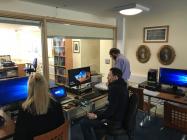Unlocking Our Sound Heritage - Cataloguing
Items in this story:
This story will have images of students from the Aberystwyth University who are studying an MA in Archive Administration carrying out the process of cataloguing for the The Story of Forest Project, which is a part of the Unlocking our Sound Heritage Project.
Cataloguing the 167 mini-disks for The Story of the Forest through the Unlocking Our Sound Heritage (UOSH) programme has had many hurdles. One of the first hurdles was understanding what was wanted from the British Library. Once the group had a rough idea of that, splitting up the work was the next hurdle. Each person who worked on it had to take the master copy in order to keep the number of copies to a minimum and to prevent doubling work, and each new worker needed the flash drive on which the master copy was kept. These exchanges also required explaining to each worker what was being done, how, and why.
After the system had been set up to give as many of the team members as possible a chance to work on cataloguing, individual issues within the catalogue had to be addressed. Among those include the usability of the flash drive on individual’s personal laptops, which was solved by using Aberystwyth University’s Hugh Owen Library computers; the identification of authorized subject headings, which was solved by starting a shared running list of headings from the Library of Congress’s website; and the uncertainty of specifics, such as the sex of the interviewer, which was resolved by listening to the individual minidisks once they were digitized. Waiting for digitization and explaining the process to those who had not worked on the catalogue yet caused the process to take longer than expected, as did a change in the understanding of what was wanted from the British Library.
A clarification on details needed in the catalogue caused another delay later in the project. The issues regarded how times were recorded as well as the difference between British Library and National Library of Wales catalogue data, including the location in the collection. These problems and the review process involved revealed a couple of duplicate recordings, which were noted on the catalogue. Once that was corrected, the UNLW numbers also had to be added based on the order minidisks were labeled in the National Library’s digital storage. This process was mostly done by one person and simply took a couple of hours to review the existing information and match it to our catalogue.
The final step was including more detailed summaries from the transcriptions. Transcription work may not be completed by the current group, though what is done has been collected in one file and will be put on the catalogue in order to provide detailed information on each digitized interview. This process will potentially clarify and add some subject headings as well.
Throughout the journey, overcoming hurdles has led to a better understanding of the collection and a clearer picture of what exists, and discovery of issues in the existing catalogues, such as times not consistently showing the same information. (Some recorded times in the pre-existing catalogue showed the general time of a recording set, while others gave a more specific time of a single recording within a set.) Through the work put into the project, those who seek to use the collection for research will hopefully have an easier time deciding if further pursuit of individual recordings is worth their effort, thereby saving their time and perhaps giving them new resources to which they would not otherwise have access.

